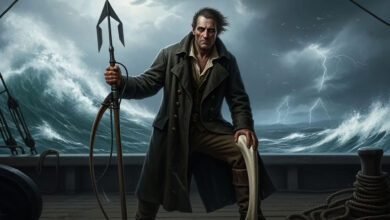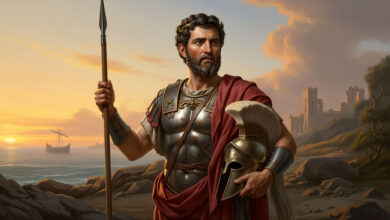Among the countless figures who shaped the destiny of the galaxy, few cast a shadow as long or as conflicted as Darth Vader. Once a gifted pilot and peacekeeper named Anakin Skywalker, he became both symbol and servant of tyranny before reclaiming his humanity in his final act. His life, marked by brilliance and tragedy, reflects the eternal struggle between duty and desire, power and compassion.
Early Life on Tatooine
Anakin Skywalker was born in 41 BBY in the desert settlements of Tatooine, a harsh Outer Rim world ruled by poverty and crime. His mother, Shmi Skywalker, raised him alone, working as an enslaved person in the service of local merchants. The boy showed extraordinary aptitude for mechanics and piloting from an early age, constructing droids and podracers from scraps he salvaged in the junkyards of Mos Espa.
Those who knew him as a child described him as kind, impulsive, and curious, traits that would later define both his greatness and his downfall. His latent sensitivity to the unseen energy known as the Force set him apart, and his confidence often bordered on fearlessness.
At the age of nine, Anakin’s life changed forever when he met Jedi Master Qui-Gon Jinn and his apprentice Obi-Wan Kenobi. Recognising the boy’s immense potential, Qui-Gon secured his freedom, believing him to be the prophesied “Chosen One” destined to restore balance to the Force.
The Jedi Apprentice
After Qui-Gon’s death, Anakin was trained by Obi-Wan Kenobi within the Jedi Order. Life in the Temple brought discipline, but it also exposed Anakin’s restless temperament. He excelled in combat and strategy, yet chafed under the strict emotional restraint required of Jedi.
Despite warnings, he formed deep attachments, most notably to Padmé Amidala, Queen and later Senator of Naboo. Their secret marriage during the Clone Wars was an act of love and defiance. For Anakin, it was also the beginning of fear: the dread of loss that would one day consume him.
During the conflict, he rose to the rank of General, leading countless missions with unmatched skill. His troops admired his courage; his peers, though wary of his impatience, could not deny his results. The war, however, blurred the line between heroism and brutality. Each victory hardened him. Each death pushed him closer to the conviction that only absolute control could end chaos.
The Fall of Anakin Skywalker
As the war reached its climax, Anakin’s visions grew darker. He dreamed of Padmé dying in childbirth and became obsessed with preventing it. When Chancellor Palpatine, secretly the Sith Lord Darth Sidious, offered him forbidden knowledge to cheat death, Anakin’s fear overcame his faith.
He accepted Sidious’s tutelage and took the name Darth Vader. His first act under this new allegiance was catastrophic. Sent to destroy the Jedi, he led troops into the Temple, slaughtering his former comrades, including the younglings he once vowed to protect. The Republic collapsed, replaced by the Galactic Empire.
For his betrayal, he paid a terrible price. In a final confrontation on Mustafar, Obi-Wan defeated him, leaving him gravely burned and broken. Rescued by Sidious, Vader was rebuilt within a suit of black armour, sustained by cybernetics and machinery. The transformation was both physical and spiritual: the death of Anakin Skywalker and the birth of the Emperor’s enforcer.
The Enforcer of the Empire
In the years that followed, Darth Vader became the face of imperial power, the commander whose very presence inspired terror. He oversaw the suppression of rebellion, hunted surviving Jedi, and enforced the Emperor’s will across the stars. His black armour and mechanical breathing became synonymous with fear.
Yet even in the depths of tyranny, remnants of the man he once was survived. Witnesses to his campaigns reported moments of restraint or compassion quickly concealed behind ruthlessness. The more he sought to silence the voice of Anakin within, the louder it grew.
Vader’s mastery of the Force became legendary. He could crush machinery, deflect blaster fire, and command fleets with icy precision. But beneath the armour lay a man imprisoned, by his body, his choices, and the grief that had first driven him to darkness.
The Rebellion and the Search for His Son
Nearly two decades into the Empire’s reign, whispers of rebellion became open defiance. When intelligence revealed that a young pilot named Luke Skywalker had destroyed the Death Star, Vader learned a truth that shattered his composure: his son had survived.
For the first time in years, a spark of hope stirred within him. He sought to find Luke, not to kill him, but to turn him, to rule the galaxy together as father and son, free from both Jedi and Emperor. His obsession returned, this time cloaked in paternal purpose rather than fear of loss.
Their first meeting ended in tragedy. On Cloud City, Vader defeated Luke in combat, severing his hand as his own had once been severed. Yet instead of killing him, he revealed the truth of their bond. “Join me,” he urged, offering power in place of wisdom, domination in place of peace. Luke refused, choosing to fall rather than follow.
Redemption on the Death Star
Two years later, father and son met again. The Emperor sought to corrupt Luke as Anakin had once been corrupted, but this time the outcome was different. When Palpatine unleashed his power upon Luke, Vader made his choice. He turned against his master, lifting the Emperor and casting him into the reactor shaft, sacrificing himself to save his son.
Mortally wounded, he asked only to see Luke with his own eyes, not through the lenses of the mask, but as a man once more. In that moment, Anakin Skywalker returned. The prophecy that had once defined his life was fulfilled: balance restored, not through conquest but through compassion.
He died aboard the Death Star as it fell, his body later burned upon a funeral pyre on Endor. Those who witnessed the flames said that for the first time in decades, his face was at peace.
Legacy
The galaxy remembers Darth Vader with both awe and sorrow. To the generation that lived under the Empire, he remains a figure of terror, the voice that echoed through prison corridors, the enforcer who silenced entire systems. Yet historians of the New Republic regard him as a man who proved that redemption is possible even for the fallen.
His life redefined the nature of power. Once he believed strength meant control; in the end, he discovered it meant surrender. His legacy endures in his son’s restoration of the Jedi Order and in the enduring lesson that the darkness within can be faced and overcome.
Reflections on Character
Darth Vader’s transformation from enslaved person to saviour traces the whole arc of human potential, the capacity for greatness and ruin within the same soul. His tragedy was not ignorance but excess: love turned to fear, fear to anger, anger to domination. He sought to protect the world from loss and instead became its instrument of suffering.
Yet his final act reminds us that even the worst of choices need not define a life forever. The power that once enslaved him became the means of liberation. His story stands as a warning and a promise: that redemption, though costly, is never impossible.
Final Word
Darth Vader remains one of history’s most haunting figures, both villain and victim, destroyer and redeemer. His life charts the perilous path between the desire to control and the need to let go. The boy who dreamed of freeing others became the man who enslaved himself, only to find release in compassion. From the sands of Tatooine to the depths of the Death Star, his story spans the extremes of existence. He was the darkness that gave rise to light, and the proof that even in a galaxy ruled by fear, hope can be reborn in a single act of love.
Darth Vader FAQ
Darth Vader was a former Jedi Knight named Anakin Skywalker who became a powerful enforcer for the Galactic Empire before redeeming himself in his final act.
His fear of loss and desire for control led him to embrace the dark side of the Force, betraying the Jedi Order and serving Emperor Palpatine.
His story mirrors the classical tragedy of a gifted man undone by his own flaws, ultimately finding redemption through love and sacrifice.
It shows that power without compassion leads to ruin, and that redemption remains possible even after great wrongdoing.
His character redefined cinematic villainy and continues to shape discussions about morality, identity, and redemption in literature and film.




